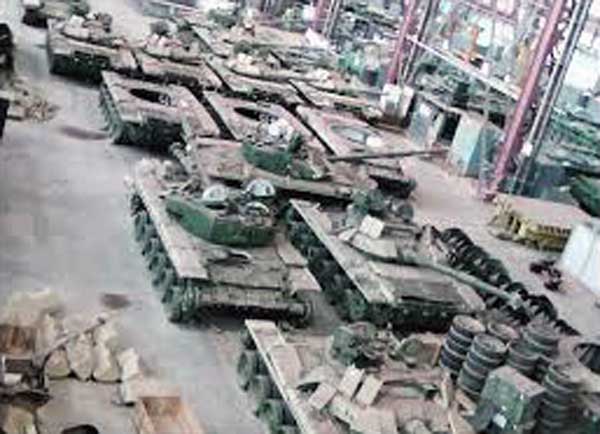IDR Blog
Skilling Gaps in Defence Production

In accordance with its “Atmanirbhar Bharat” policy,the Government on August 10 announced a ban on import of 101 weapons, platforms and equipment. Later, none other than Prime Minister Narendra Modi surprised the participants at a Federation of Indian Chambers of Commerce and Industry-event by his “unscheduled address”, in which he asserted that, “Our commitment to self-sufficiency in defence production is not limited to talks or papers. The effort in the last few years has been to break all the shackles associated with the defence sector. Our aim is to increase production in India, develop new technology in India, and maximise expansion of private sector.” In fact, the Prime Minister went to the extent of “making” India a major exporter of arms in near future.
It is particularly noteworthy when the Prime Minister says that “the commitment to self-sufficiency in defence production is not limited to talks or papers”. After all, self-sufficiency in arms is not exactly a new goal; it has been stressed upon by every government in recent years. We have heard enough of schemes like “make-Indian” and “buy-Indian” in the defence sector. Obviously, the goal has not been realised and that explains why the Prime Minister now is talking of going beyond “talks”.
Experts have pointed out many reasons why there has been a gap between the goal and the reality with regard to our defence production- capability. In fact, we have carried out an important essay on the subject in this issue of the magazine. Therefore, I will like to limit myself in pointing out only two aspects of the problem. First, and this may sound ironical, producing high-tech weapons or platforms at home either on your own or in collaboration with a foreign vendor may not be cheaper than the option of purchasing the item off the shelf from an original equipment manufacturer (OEM). For instance, the Su-30 MKI is developed by Russia’s Sukhoi and built under licence by India’s Hindustan Aeronautics Limited (HAL) for the Indian Air Force. But then many studies say that the HAL-made MKIs are much more expensive than if these would have been bought from Russia. Similarly, there is a huge cost difference between the cost of the Hawk trainer aircraft manufactured by British Aerospace and those made by HAL. Even, the original deal to procure Rafale fighter jets from France in 2012 did not fructify mainly due to the fact that producing them at HAL would have proved costlier and more time-consuming, something the OEM Dassault was not prepared for.
Secondly, there is the more important issue of quality of the defence products manufactured by our eight defence public sector undertakings, 41 Ordnance Factories, and 49 Defence Research and Development Organisations (DRDO) establishments. Let alone their records in not meeting the deadlines of promised deliveries, the defence forces (the end-users) reject, more often than not, their products for want of quality.
Of course, there is a very valid counter logic here. Citing the experience of China, it has been said that like the PLA our armed forces should not overstress the quality factor and thus encourage the indigenous base to produce more and more and thus learn from experience to develop better systems in course of time. I do not want join this debate. My simple point is that as things stand today, our indigenous base of developing quality strategic products in areas other than missiles, nuclear and space, is rather poor.
What does affect our quality? One reason is that since we invest the least, in comparison with technologically advanced countries, in basic research (R&D) in scientific and educational establishments, we are always dependent on foreign technologies, which, in turn, do not come to us easily. Over the last 20 years or so, India’s expenditure on R&D has been stagnant at as low as 0.6% – 0.7% of the GDP, much lower than countries like South Korea at 4.3%, Israel at 4.2% and Japan at 3.4%. The US invests around 2 .84 % of its GDP on R&D, but then given its large GDP this amount is huge ($553 billion in 2018). Even China, with an R&D expenditure (USD 275 billion in 2018) spends about 2.2 percent of its GDP.
The other reason that is often underplayed is the quality man power in India. Prime Minister Modi often exaggerates India’s population dividend. But the bitter truth is that most our youth is unemployable, particularly in establishments developing strategic or defence products. We do not have employable engineers with a background in mecha-tronics, composites, and system integration knowledge, so important in technology-driven defence sector. Our DRDO is not getting enough engineers and young scientists despite its best attempts; the organisation, rather, has seen a number scientists resigning to avail of better opportunities elsewhere.
On the contrary, just see the situation in countries producing world’s major weapon systems and platforms. France has specialised engineering schools like “Institut Superier de l’Aeronautique et de l’Espace (ISAE)” and “Ecole Nationale de l’AviationCivile (ENAC)” in Toulouse and “Ecole Nationale Superieure de Mecnique et d’Aerotechnique (ENSMA)” in Poitiers that produce engineers for its defence industry. The base of the successful manufacturing industry in Germany is built on the fine and firm foundation of “Apprenticeship Training”. The core of the model here is “dual training’ whereby trainees split their days between classroom instructionat a vocational school and on-the-job time at a company. The theory they learn in class is reinforced by the practice at job. This arrangement lasts for two to four years, depending on the sector. And this arrangement suits the prospective employer and potential employees eventually in jobs that cement the relationship further.
Important, thus, is the factor of skills in general. In India, the skilled man power – base is pathetic, to speak the least. It is said to be at 4.69% of total workforce, compared to 24% in China, 52% in the US, 68% in the UK, 75% in Germany, 80% in Japan and 96% in South Korea. Of course, it is to the credit of the Modi-government that it is trying to promote skills, evident from its proposed new education policy. But then, there is a long path to cover.
In sum, the most challenging task in becoming self reliant or “Atmanirbhar” in defence is developing men/women who are capable to produce quality weapon systems and platforms. A focused skill development policy for this sector is the need of the hour. We need as many talented engineering graduates to enter the core manufacturing sector (of which military-industrial establishment is a part) as in the glamorous IT sector, and to retain them once they enter.
Courtesy: https://udayindia.in/2020/09/22/skilling-gaps-in-defence-production/




